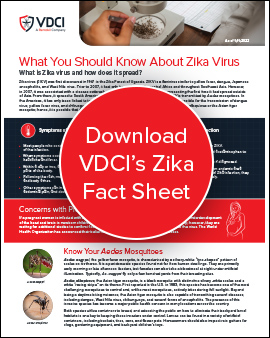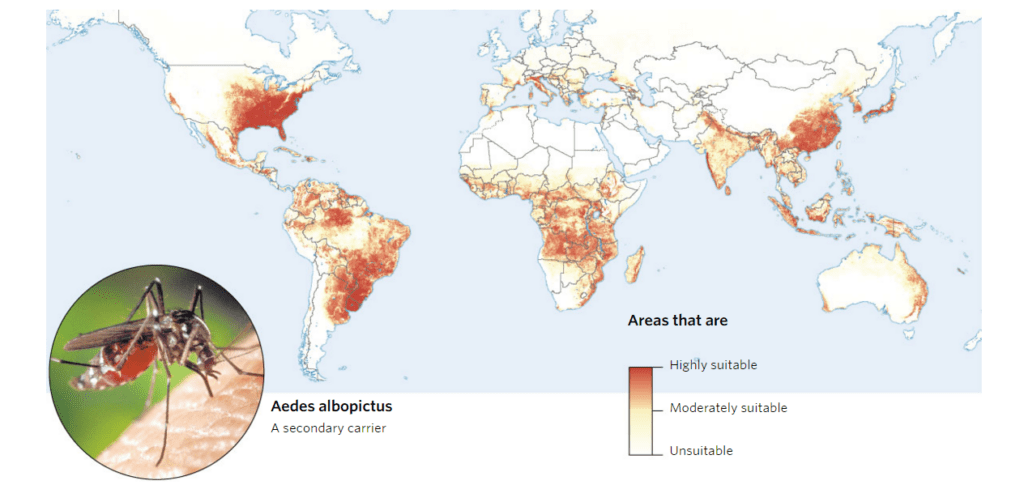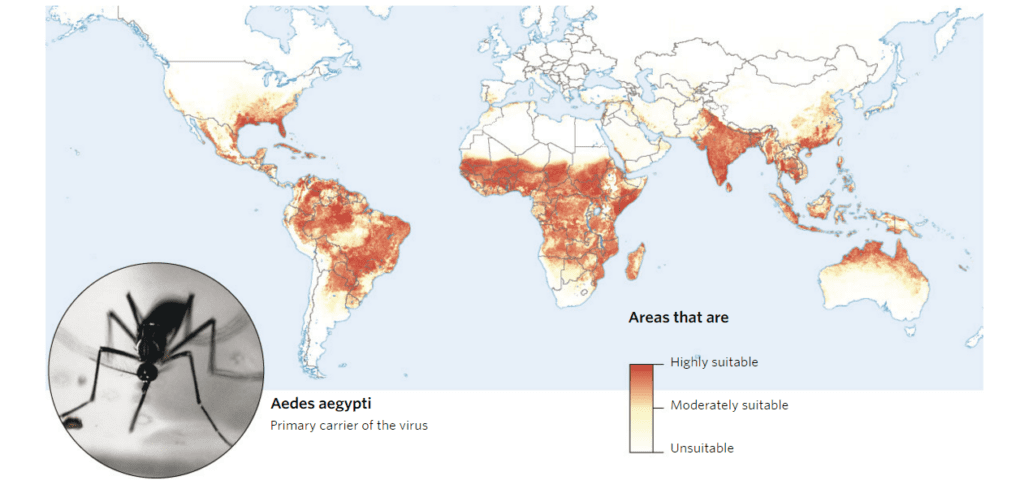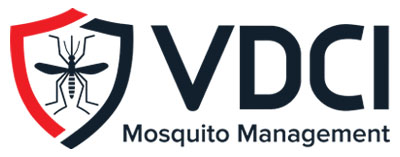What is Zika Virus and How Does it Spread?
Zika virus (ZIKV) was first discovered in 1947 in the Zika Forest of Uganda. ZIKV is a flavivirus similar to yellow fever, dengue, Japanese encephalitis, and West Nile virus. Prior to 2007, it had only been detected in central Africa and throughout Southeast Asia. However, in 2007, it was associated with a disease outbreak on Yap Island in the South Pacific, representing the first time it had spread outside of Asia. From there, it spread to South America with human cases first reported in 2014. ZIKV is transmitted by Aedes mosquitoes. In the Americas, it has only been linked to transmission by Aedes aegypti. Ae. aegypti is also responsible for the transmission of dengue virus, yellow fever virus, and chikungunya virus. Recently in Africa, the virus was detected in Aedes albopictus or the Asian tiger mosquito; hence, it is possible that Ae. albopictus could vector the virus in the Americas.

Signs and Symptoms of Zika Virus
Symptoms
- Most people who contract the Zika virus show no symptoms of the infection.
- When symptoms occur, they typically begin with a mild headache and fever.
- Within a day or two, a maculopapular rash may appear and can cover many parts of the body.
- Following the rash, people generally report continued fever, malaise, and body aches.
- Other symptoms can include diarrhea, constipation, abdominal pain, and dizziness.
Concerns with Pregnancy and Perinatal Infections
If a pregnant woman is infected with Zika virus, it may result in microcephaly, a birth defect causing underdevelopment of the head and brain in newborn children. The CDC has officially linked Zika virus to microcephaly; however, they are waiting for additional studies to confirm if cases of Guillain-Barré syndrome can also be linked to the virus. The World Health Organization has announced their belief that the virus can contribute to both diseases.
Treatment of Zika Infection
- Currently, there is no vaccine or cure for ZIKV.
- Treatment for symptoms includes rest and the use of acetaminophen to relieve fever.
- Patients should also be advised to drink plenty of fluids if diagnosed.
- If anyone has recently traveled to a known endemic area and are displaying any of the symptoms of Zika infection, they should consult their physician immediately.
Zika and the United States
In 2024, 19 travel cases were reported and 9 locally acquired cases were reported. It’s important to note that cases acquired through other routes (e.g., laboratory transmission) are classified as travel-associated for reporting. While antibody testing has been used for Zika diagnosis in U.S. territories since 2019, it’s important to note the limitations: long-lasting antibodies and cross-reactivity with dengue make it difficult to determine the timing and specific cause of infection. Notably, no confirmed Zika virus disease cases have been reported in these territories since 2019.
A portion of the United States is at a higher risk because of climate and the presence of Aedes mosquitoes. Both Ae. aegypti and Ae. albopictus are limited in their distribution in the U.S. Therefore, although select areas of the country are at a higher risk, it is unlikely that ZIKV will become a disease that circulates in the local mosquito populations throughout the U.S. Most U.S. cases were imported from travelers who contracted the virus in other countries and returned to the U.S. while infected. One of the factors accelerating the spread of Zika virus throughout the Americas could be that it does not appear to require an animal reservoir host, like West Nile virus. In other words, non-infected mosquitoes are able to acquire the virus after feeding directly on infected people, which allows ZIKV to spread rapidly where abundant, competent vector mosquitoes and humans are present together.


Know Your Aedes Mosquitoes
Aedes aegypti, the yellow fever mosquito, is characterized by a silvery-white “lyre-shaped” pattern of scales on its thorax. It is a peridomestic species found not far from human dwellings. They are primarily early morning or late afternoon feeders, but females can also take a bloodmeal at night under artificial illumination. Typically, Ae. aegypti fly only a few hundred yards from their breeding sites.
Aedes albopictus, the Asian tiger mosquito, is a black mosquito with distinctive silvery-white scales and a white “racing stripe” on its thorax. First reported in the USA in 1983, this species has become one of the most challenging mosquitoes to control and, unlike most mosquitoes, actively bites during full sunlight. Beyond being a daytime biting nuisance, the Asian tiger mosquito is also capable of transmitting several diseases, including dengue, West Nile virus, chikungunya, and several forms of encephalitis. The presence of this invasive species has become a major public health concern in many locations across the country.
Both species utilize containers to breed, and educating the public on how to eliminate their backyard larval habitats is one key to keeping these invaders under control. Larvae can be found in a variety of artificial containers, including buckets, tires, cans, and flower pots. Homeowners should also inspect rain gutters for clogs, gardening equipment, and backyard children’s toys.
Controlling Aedes aegypti/albopictus and Zika Virus
An Integrated Mosquito Management (IMM) program is essential to helping prevent mosquito bites and transmission of serious vector diseases in the United States. As part of an effective IMM program, VDCI recommends a 4-pronged approach to target all phases of the mosquito’s life cycle.
Community understanding of how to properly eliminate mosquito breeding habitat and take personal protective measures is critical. Furthermore, distribution of educational pieces is important for treating symptoms and aids public health officials in identifying ZIKV problem areas.
2: Surveillance
In order to understand the risk and address the threat appropriately, it is critical to determine the mosquito distribution, density, and species composition throughout the target area. Surveillance will also provide direct evidence of an increased transmission risk of Zika virus.
When mosquito larvae are detected in an area, trained and experienced ground crews reduce breeding habitat when possible, then preferentially apply Bacillus thuringiensis var israelensis (Bti) to remaining areas of standing water, stagnant pools, and water-holding containers. Aerial and ground application of larvicide via ULV equipment can provide control in hard to reach container habitats.
VDCI recommends the deployment of two-person teams to conduct targeted ULV applications combined with residual “barrier” applications via backpack applicators to mosquito harborage areas near homes and other structures. In addition, when the disease risk warrants it, truck and aerial ULV applications should be utilized to reduce the adult mosquito population. When combined with our larvicide efforts, these methods have proven highly effective at significantly reducing local populations of the target mosquitoes.


